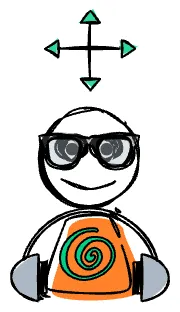The Energetics of Anxiety
Anxiety: a state of uneasiness or distress about future uncertainties
The word anxiety is derived from the Latin 'anxietas' which means 'to torment' or 'to choke'.
Torment: (to cause) great physical pain or mental anguish
The word torment means 'to twist; a twisted rope’.
"We can think of anxiety as twisted."
Anxiety is often experienced as a mental and emotional state where thoughts and feelings become entangled, much like a twisted rope.
This idea of twisting also represents the cyclical and often self-reinforcing nature of anxious thoughts, where worries loop back on themselves, creating a sense of being trapped or choked by one's own mind.
This twisting element highlights how anxiety can distort perceptions, making challenges seem insurmountable and creating a sense of internal turmoil.

"Can you get a sense of this 'twisted' feeling? Like everything is turning in on you?"
What would it feel like to experience the OPPOSITE of this?"
In engineering, the concept of twisting or torsion involves the application of rotational force, which can cause stress and deformation in materials.
This parallels the experience of anxiety, where internal pressures and external stressors twist the mind and emotions, leading to psychological strain.
Just as engineers must account for torsion to prevent structural failure, individuals must address the twisting nature of anxiety to maintain mental well-being.
Anxiety and Twisting
The derivation of anxiety as a "twisted rope" emphasises its constrictive and entangling nature, as we often get 'caught up' in our emotions.
We can apply this 'conceptual understanding' in several ways:
1. Cognitive Distortion: Anxiety often involves distorted thinking patterns, where fears and worries twist reality, leading to exaggerated perceptions of threat or danger.
2. Emotional Entanglement: Anxious feelings can become intertwined, making it difficult to separate rational concerns from irrational fears, much like untangling a knotted rope.
3. Physical Manifestation: Anxiety can manifest physically, with symptoms such as tightness in the chest or throat, akin to the sensation of being choked or constricted.
What Can We Do...
Looking at it from an 'energetic perspective' -- we can:
Unwind -- physically, mentally and emotionally (release)
Reverse the pattern (balance)
Reduce the counterforce (reaction to response)
Increase flow in desired direction (intentional thoughts)
Apply adaptive measures = reengineer (identity)
This is the essence of DSA -- once you can 'See' (mind) and 'Feel' (body) the nature of your problem, you can apply it's opposite to return to a Neutral State
.
Then, when you're ready, you can start to imagine and engage with a new potential state.
This can all be done energetically, using our mind to guide the changes needed, while our body’s natural receptive centres allow us to feel if and when change is occurring.
But, in order to know if a change has occurred, we must first know what we are dealing with.
We have to know who, what and where we are — before we can know who, what and where we want to be.

"Where to next?"
You can check out this short audio: